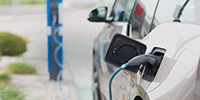Why are deep cycle batteries 12V used in solar energy?
DEEP CYCLE BATTERIES FOR SOLAR POWER SYSTEMSSolar Batteries (Deep Cycle Solar Batteries) are a key component in a stand-alone renewable energy system—whether the solar system is off-grid or the battery bank is used for backup in case of electrical grid failure. If you are installing wind, solar panel or hydroelectric system that will be tied to your utility grid, you will still need deep cycle batteries if you are trying to use power in the event of an outage. Without deep cycle batteries, you can only use power at the time you produce it (i.e. you will not have power when the sun isn't out if you don't have batteries in your solar electric system). In renewable energy systems, deep cycle batteries provide the energy storage for your system. Unlike your car battery, deep cycle batteries that are used in renewable energy applications are meant to be discharged and recharged (cycled) repeatedly. To maintain healthy batteries and prolong battery life, most manufacturers suggest limiting the depth of discharge to about 20%. (That means the deep cycle batteries will be at 80% capacity or better.) At the very least, do not allow the batteries to be discharged below 50% Depth of Discharge (DOD). Often an inverter will have a Low Voltage Disconnect feature that will disconnect loads at a given set point. Low voltage alarms can provide audible warnings as well. Ammeters, Voltmeters, Battery Monitors can help better maintain deep cycle battery health and provide statistics about the overall health of the system. What is a "Sealed Lead Acid" battery (VRLA's)Sealed Lead Acid batteries are often referred to as being "maintenance free" or valve regulated. In a sealed lead acid battery the unit is sealed, meaning that water loss is kept to a bare minimum and also that you needn't put any water into the battery. Most of the sealed VRLA batteries are recombinant which essentially means that the water lost through the venting of hydrogen and oxygen in a flooded battery is the most common types of Sealed Lead Acid or SLA batteries that we carry are the AGM (Absorbed Glass Mat) batteries; another is the GEL type of battery. AGM batteries have a very fine Boron-Silicate glass mat in between the plates inside the battery. The mats are about 95% filled up with electrolytes rather than completely saturated. The considerable advantage of this type of battery is that it can be operated in almost any orientation and will even function underwater. They will also never leak, even if punctured. GEL batteries have the electrolyte stored in a gel form; this also won't spill out even if the batteries are broken and also prevents the stratification that other battery types can have. Gel cells, however, do have some limitations; they take a slower charge than a comparable sized AGM battery. If they are overcharged voids can form in the gel which permanently reduces the battery capacity. For deep cycle applications however the Sealed Lead Acid type of battery can be a great deal more expensive than a comparable Flooded Lead Acid battery. However, there are times when a sealed battery will better meet your needs than a flooded battery would. Particularly marine applications where stability isn't always a given, and ventilated spaces are hard to come by are often well-tailored to a sealed lead-acid battery. One other advantage that AGM and Gel batteries have over flooded types is the low self-discharge rate. Where a Flooded battery will lose about 13% of its charge in a month, a Gel or AGM will lose 1% -3%. How long will my battery last? How long a battery will last depends hugely upon the way it is used and how well the battery is maintained. Both overcharging and undercharging will have serious adverse effects on the lifespan of a deep cycle battery. In particular, you can seriously shorten the lifespan of a battery if it is used in a deep cycle application that it was not designed for. An example of this would if you were to use an automotive starting battery as a deep cycle battery. General expectations for batteries if deep cycled (these are just approximate guidelines): ● Starting battery (Automotive battery etc): 3-13 months The main things that you can do to ensure you get the maximum value out of your deep cycle batteries are to keep them maintained. This means keeping the water to the appropriate level, trying to prevent them from discharging them more than 50% of their total capacity and having appropriate charging systems in place. The charging is of special importance because both over and undercharging will severely limit the life of your batteries, also if your batteries will see an extended period without being used you should ensure they are routinely checked, cleaned and fully charged before being stored. Also in some cases, it can be a good idea to put your batteries on a maintenance charge over long periods of disuse. Battery Cycles vs. Battery Lifetime? Often the lifespan you can expect to get out of your battery is referred to in terms of "cycles". A battery cycle is one complete discharge and recharge cycle. The discharge state of a battery is often measured in Depth of Discharge (DOD). This refers to how far down the battery has been taken, for instance, a battery that has 25% of its capacity remaining would be said to be at 75% DOD. The lifetime of a battery is directly related to the depth of the discharge that it regularly experiences. Lead-acid batteries are fickle things. If you subject a deep cycle battery to 80% DOD on a regular basis you will get roughly half the life out of your battery than if you were to cycle it to 50% DOD. While this doesn't mean that you can't go down to 80% DOD you should generally try to design your battery banks to allow for cycling at around 50%. Conversely there is also an upper limit on the DOD of a battery, usually, a battery that is only regularly cycled down to 5% or less will not last as long as a battery cycled to 10% or more. This is because on smaller cycles the Lead Dioxide can clump up around the positive plates. On heavier discharges, this would be more of an even film. What is an "amp-hour" and how much capacity do I need? Battery capacity is rated in amp-hours. This is a measure of how much amperage can be drawn from a fully charged battery over time until it is discharged (for a 12-volt battery this is when it reaches 10.5v). Then the amps are multiplied by the amount of time taken to get the Ah rating. As an example of this, if you had a device that pulled 25 amps and you used it for 30 minutes then the amp-hours used up would be 25(amps) x 0.5(hours) = 12.5 amp-hours. The standard and most widely accepted rating period for deep cycle batteries is 20 hours. This means that the battery was discharged down to 10.5 volts over 20 hours while measuring the total amp hours it supplies. Sometimes, however, the time period can differ, in some circumstances knowing the 6-hour amp rating may be more useful and in others, the 100 amp hour rating may be used. Due to something called the Peukert effect a battery gives higher amp hours when it is discharged over a longer time period. For instance, the rated Capacity for the Trojan T105-RE is 225 at 20 hours and 250 at 100 hours. How does temperature affect my batteries? The capacity and life expectancy of a lead-acid battery will vary depending on the temperatures that it operates in. Battery capacity increases in hotter temperatures though battery life decreases. Also in the colder temperatures, the battery will have less capacity but it will last longer. At freezing battery capacity is about 20% lower, at 122 degrees F battery capacity is around 12% higher. The charging voltage for a battery will also vary from 2.74 volts per cell (16.4 for a 12v battery) at -40c to 2.3 volts per cell (13.8 on a 12-volt battery) at 50c. Some charge controllers have this temperature correction built-in. Does my deep cycle battery suffer from memory effect? Lead Acid Batteries do not have a memory, in fact completely discharging lead-acid batteries will lead to a dramatic shortening of the lifespan of the battery. |













